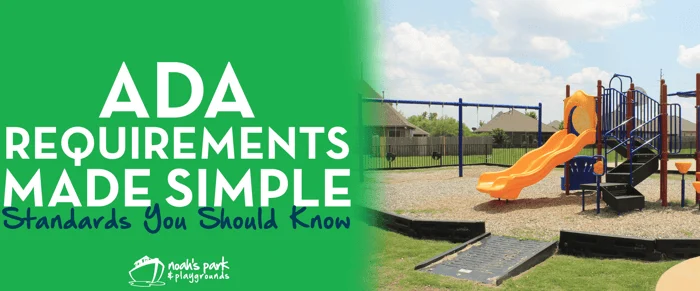
July 29th, 2015
Understanding ADA Requirements for Playgrounds: What You Need to Know
When you're the principal of a school, the president of your neighborhood HOA, or the director of a daycare center, hearing those three little letters, ADA, can feel overwhelming. What does it mean? How does it apply to your specific situation? And most importantly, how do you ensure your playground meets all ADA requirements without blowing your entire budget?
Let's break it down so you can feel confident moving forward.
What is ADA and Why Does It Matter for Playgrounds?
ADA stands for the Americans with Disabilities Act, a civil rights law that prohibits discrimination against individuals with disabilities in all areas of public life, including schools, daycares, and parks. ADA guidelines were created to ensure that people with disabilities, including children, have equal access to public spaces, including playgrounds.
When it comes to playgrounds, ADA compliance ensures that children with physical, cognitive, or sensory challenges can access and enjoy equipment alongside their peers. That means making sure your playground includes accessible routes, ground level play components, compliant surfacing, and equipment that all kids can safety and independently enjoy!
Does ADA Apply Differently to Schools, HOAs, and Daycares?
Yes, and no.
The core ADA requirements remain the same across all public and commercial entities. However, how you interpret and apply those requirements may vary depending on your setting, finding, and the community you serve.
- Schools (especially public schools) are required by federal law to provide accessible playgrounds, often as part of broader educational equity mandates.
- Daycare centers, especially those licensed or received public funding, must also comply with ADA requirements to ensure all children can participate equally.
- Homeowners Associations may not be federally mandated to meet ADA standards in all cases, but it's highly encouraged, especially if the playground is publicly accessible or receives state or local funding.
Understanding the scope of your obligations is the first step to staying compliant and inclusive.
Budgeting for ADA Compliance: Smart Planning Tips
One of the biggest concerns for any organization planning a new playground is cost. ADA compliance doesn't have to break the bank, but it does require intentional planning. Here are a few ways to stretch your budget while still meeting accessibility guidelines.
1. Prioritize Safety Surfacing
Surfacing is one of the most important, and often most overlooked, elements of ADA compliance. Not all surfacing is considered accessible. For example, loose fill materials like sand and pea gravel are not ADA-compliant.

Instead, opt for:
- Wood Mulch: An affordable, partially accessible option when maintained properly.
- Poured In Place Rubber or Rubber Tiles: More expensive upfront, but fully compliant and low maintenance.
- Synthetic Turf with Accessible Underlayment: Offers both comfort and compliance.
Working with experts like those at Noah's Park & Playgrounds can help you choose the most budget friendly compliant surfacing option for your environment.

2. Incorporate Ground Level Activities
To meet ADA requirements, a certain number of play components must be located at ground level and accessible by wheelchair or mobility device. These include activity panels, musical instruments, and inclusive play events like talk tubes or sensory walls.
Adding more ground level features is an easy and affordable way to boost compliance without adding expensive elevated equipment.
3. Plan for Accessible Routes
Accessible routes connect your play area to sidewalks, parking lots, and other amenities. These paths should be smooth, wide enough for mobility devices, and have minimal slope. Be sure to factor them into your budget and design.
4. Phased Installation
If your budget is limited, ADA compliance can be approached in phases. Start by adding accessible surfacing and essential ground play elements, then add more features over time. Our design team can help you map out a plan that fits your timeline and finances.
Common Mistakes to Avoid
While planning an ADA compliant playground, be sure to avoid these costly missteps:
- Choosing a non-compliant surfacing like sand, pea gravel, or mulch that hasn't been tested for impact and accessibility.
- Focusing only on ramps and ignoring accessible play value. ADA is about participation, not just access.
- Underestimating maintenance. Even ADA compliant surfaces like wood mulch require regular top offs and raking to remain compliant.
This is where working with experienced professionals, like our team at Noah's Park & Playgrounds, make a big difference.
You Don't Have to Do It Alone
The good news? You don't have to figure this out by yourself.
At Noah's Park & Playgrounds, our sales and design professionals are ADA certified and highly knowledgeable in inclusive playground standards. We don't just sell playground equipment, we help you understand how to use your budget efficiently to meet compliance requirements and design a space that welcomes children of all abilities.
Whether you're working on a school campus, church playground, a neighborhood green space, or a daycare yard, we can walk you through:
- ADA surfacing options
- Age appropriate inclusive play equipment
- Layout and route planning
- Code compliance and documentation
Our goal it to help you serve your community with a playground that's fun, safe, and accessible for every child.
Final Thoughts: Inclusion Starts with the Right Design
Creating an ADA-compliant playground isn't just about checking off legal boxes—it’s about designing a space where every child feels seen, valued, and included. When you prioritize accessibility, you create opportunities for connection, play, and joy for all families in your community.
With support from experienced professionals, thoughtful planning, and a clear understanding of ADA standards, you can build a playground that welcomes everyone—and stands as a model of inclusivity in your neighborhood or organization.
Let Noah’s Park & Playgrounds help you bring that vision to life.

Want to Learn More?
To help you take the next step, we recommend reading this informative article that breaks down the ADA standards for playgrounds, how they apply to different facilities, and what to consider when planning your project:
link to article
Still have questions?
